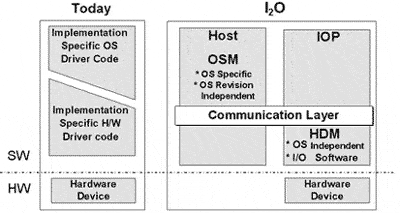Intelligent Input/Output (I2O) represents a significant stride in computer architecture, primarily developed by a consortium led by Intel. This innovative approach focuses on improving system performance by offloading intensive I/O tasks from the Central Processing Unit (CPU), thus reducing the CPU’s burden and enhancing overall efficiency. In this article, we’ll delve into the intricacies of I2O, examining its architecture, functionality, impact, and current relevance in the world of computing.
In this article:
- What is I2O?
- History and Development of I2O
- How I2O Works
- Benefits and Impact of I2O on System Performance
- References

1. What is I2O?
Intelligent Input/Output is a hardware architecture developed by a consortium led by Intel that improves the input/output (I/O) performance of systems by relieving the central processing unit (CPU) of interrupt-intensive I/O tasks. Intelligent Input/Output (I2O) also provides a way of standardizing I/O device drivers across different operating systems and hardware platforms.
I2O was conceived to address the bottleneck caused by the increasing load of I/O tasks on the CPU, which can significantly hamper overall system performance.

The Concept and Architecture of I2O
At its core, I2O employs a layered approach. It separates the I/O functions from the main processor and delegates them to specialized I/O processors, known as I2O adapters. These adapters handle the I/O tasks independently, thereby reducing the load on the CPU. This architecture is designed to be scalable and efficient, enabling the addition of more I/O processors as needed without affecting the CPU’s performance. It allows for a modular approach to handling various I/O tasks such as disk access, networking, and communication interfaces.
2. History and Development of I2O
Origins and Evolution
I2O emerged in the late 1990s as a collaborative effort led by Intel, alongside other industry giants. It was developed to address the growing need for more efficient I/O processing in complex server and computing environments. The goal was to create a standard that could be adopted across various hardware platforms and operating systems.
Key Contributors and Milestones
The I2O architecture was shaped by contributions from major tech companies, including Microsoft, IBM, and Sun Microsystems. Notable milestones in I2O’s development include:
- The Formation of the I2O Special Interest Group: A consortium of industry leaders that came together to develop and promote the I2O standards.
- Release of Initial Specifications: The first specifications laid the groundwork for I2O’s architecture and implementation.
- Adoption in Server Environments: I2O gained traction in server-based applications where high-speed data processing and efficiency were crucial.
3. How I2O Works
I2O, or Intelligent Input/Output, fundamentally changes how input/output tasks are handled in a computer system. Traditionally, the CPU is responsible for managing all I/O tasks, which can significantly burden its processing capacity. I2O addresses this by offloading these tasks to dedicated I/O processors, known as I/O Processors (IOPs).
In an I2O system, when an I/O request is generated, it is intercepted by the I2O software, which then delegates the task to an appropriate IOP. This processor independently handles the I/O operation, including data transfer, error handling, and communication with peripheral devices. Upon completion, the IOP notifies the main CPU that the task is complete, allowing the CPU to focus on core processing tasks.
I2O also standardizes device drivers by dividing them into two components:
- A Hardware Device Module (HDM), which directly interfaces with the peripheral being managed
- An Operating System Service Module (OSM), which interfaces with the operating system on the machine
In addition, an intermediate layer between the HDM and OSM provides independence between them by providing standard communication mechanisms that allow any HDM for any peripheral to interoperate with any OSM for any operating system.
Detailed Analysis of I2O Components and Functioning
The key components of an I2O architecture include:
- I/O Processors (IOPs): Specialized hardware components that handle I/O tasks. Each IOP operates independently and is optimized for specific types of I/O operations.
- I2O Software Layer: A critical component that manages the communication between the CPU and IOPs. It routes I/O requests to the appropriate IOP and handles the necessary software interactions.
- Message-Passing Interface: I2O uses a message-passing model, which is more efficient and scalable compared to traditional interrupt-driven I/O processing. This model facilitates better communication and synchronization between the CPU and IOPs.
4. Benefits and Impact of I2O on System Performance
Enhanced System Efficiency
The primary benefit of I2O is the significant reduction in the CPU’s workload, leading to enhanced overall system efficiency. By offloading I/O processing:
- Reduced CPU Load: The CPU is freed from routine I/O processing tasks, allowing it to focus on higher-priority computational tasks.
- Improved Data Throughput: With dedicated IOPs, data transfer and processing are more efficient, improving the overall throughput of the system.
- Scalability: I2O architecture allows for the addition of more IOPs as needed, making it highly scalable for growing I/O demands.
Case Studies Demonstrating I2O’s Effectiveness
Several case studies highlight I2O’s impact:
- Server Environments: In high-traffic server applications, I2O has been shown to significantly improve data processing speeds and server responsiveness.
- Database Systems: I2O has enhanced the performance of database systems, particularly in handling large volumes of data and concurrent I/O operations.
- Network Infrastructure: I2O has improved the efficiency of network devices, reducing latency and increasing data processing capabilities.
5. References
- “Intel Expands I/O Building Block Family“, Intel News Release, Jan 2000
- “I20 SIG to meet in Redmond“, CNET, Jan 1997